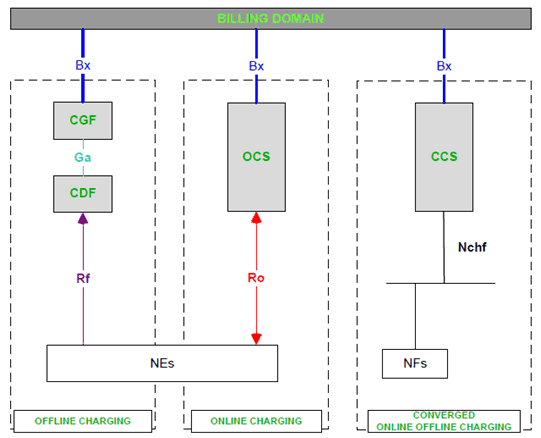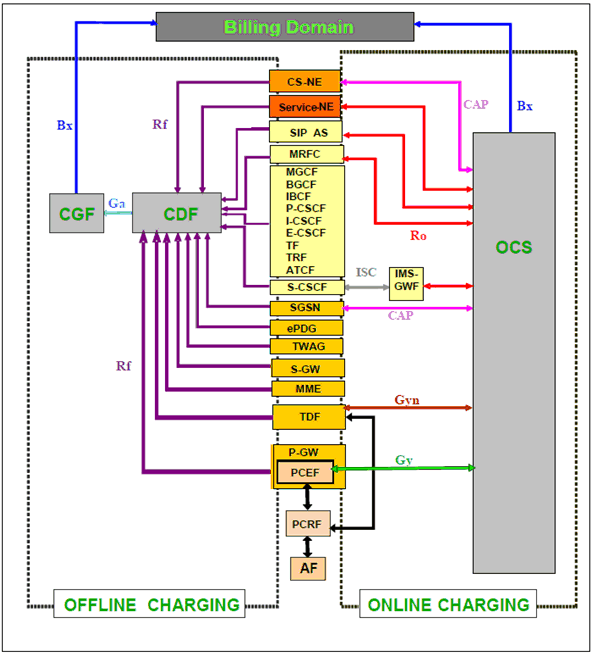Content for TS 32.240 Word version: 19.0.0
4 Common charging architecture and framework
4.0 Introduction
4.1 Charging mechanisms
4.1.0 General
4.1.1 Offline charging
4.1.2 Online charging
4.1.3 Converged charging
4.2 High level common architecture
4.2.1 General
4.2.2 Common architecture - reference points
...
...
4 Common charging architecture and framework p. 21
4.0 Introduction |R12| p. 21
The main requirements and high-level principles for charging and billing across the domains, subsystems and services that comprise 3GPP networks are established in the TS 22.115. In order to fulfil these requirements, appropriate charging information needs to be generated and collected by the network elements or network functions of the 3GPP network and forwarded to appropriate charging and billing systems.
Several logical charging functions are needed in the network in order to provide the functionality described above for online and offline charging, respectively. These charging functions are specified in detail in this clause, together with the reference points and service based interface that are used to transfer charging information between those functions. While the overall possibilities that exist within the 3GPP standards for the physical mapping of these logical functions are described in the present document, the exact situation that applies to the various domains, subsystems and services of the network is specified in the middle tier TS that is specific to that domain/subsystem/service (i.e. TS 32.25x, TS 32.26x and TS 32.27x).
In offline charging, the charging information is transferred from the network to the Billing Domain (BD), where it is processed for billing and/or statistical purposes, at the discretion of the PLMN operator. While the internal functions of the BD are outside the scope of 3GPP standardisation, the reference point for the charging information transfer from the network to the BD does form a part of the 3GPP standards and is therefore also specified in the present clause.
In online charging, the charging information is transferred from the network to the Online Charging System (OCS) or to the Converged Charging System (CCS). The OCS or CCS, in turn, may have an offline charging reference point used to forward charging information to the BD that is similar in scope and intent to the offline charging case described in the previous paragraph. Those areas of the OCS and CCS that form part of the 3GPP standards (functions, reference points and service based interface) are also described in the present clause. All other aspects of the OCS and CCS are outside the scope of 3GPP.
4.1 Charging mechanisms p. 22
4.1.0 General |R12| p. 22
3GPP networks provide functions that implement offline and/or online charging mechanisms on the domain (e.g. EPC), subsystem (e.g. IMS) and service (e.g. MMS) levels. In order to support these charging mechanisms, the network performs real-time monitoring of resource usage on the above three levels in order to detect the relevant chargeable events. The charging levels are further described in clause 5.3.
In offline charging, the resource usage is reported from the network to the BD after the resource usage has occurred. In online charging, a subscriber account, located in an OCS or CCS, is queried prior to granting permission to use the requested network resource(s).
Typical examples of network resource usage are a voice call of certain duration, the transport of a certain volume of data, or the submission of a MM of a certain size. The network resource usage requests may be initiated by the UE (MO case) or by the network (MT case).
Offline and online charging may be performed simultaneously and independently for the same chargeable event. Clause 5.5 provides further insight into potential utilisation of the charging information produced by the offline and online charging mechanisms.
4.1.1 Offline charging p. 22
Offline charging is a process where charging information for network resource usage is collected concurrently with that resource usage. The charging information is then passed through a chain of logical charging functions that are further explained in clause 4.3.1 and clause 4.3.3. At the end of this process, CDR files are generated by the network, which are then transferred to the network operator's BD for the purpose of subscriber billing and/or inter-operator accounting (or additional functions, e.g. statistics, at the operator's discretion). The BD typically comprises post-processing systems such as the operator's billing system or billing mediation device.
In conclusion, offline charging is a mechanism where charging information does not affect, in real-time, the service rendered.
4.1.2 Online charging p. 22
Online charging is a process where charging information for network resource usage is collected concurrently with that resource usage in the same fashion as in offline charging. However, authorization for the network resource usage must be obtained by the network prior to the actual resource usage to occur. This authorization is granted by the OCS or CCS upon request from the network.
When receiving a network resource usage request, the network assembles the relevant charging information and generates a charging event towards the OCS or CCS in real-time. The OCS or CCS then returns an appropriate resource usage authorization. The resource usage authorization may be limited in its scope (e.g. volume of data or duration), therefore the authorization may have to be renewed from time to time as long as the user's network resource usage persists.
Note that the charging information utilized in online charging is not necessarily identical to the charging information employed in offline charging.
In conclusion, online charging is a mechanism where charging information can affect, in real-time, the service rendered and therefore a direct interaction of the charging mechanism with the control of network resource usage is required.
4.1.3 Converged charging |R15| p. 22
Converged charging is a process where online and offline charging are combined. The charging information is utilized by CCS in one converged charging service which offers charging with and without quota management, as well as charging information record generation.
4.2 High level common architecture p. 23
4.2.1 General |R15| p. 23
The architectural differences between the domains (e.g. PS), services (e.g. MMS) and subsystems (e.g. the IMS) affect the way in which the charging functions are embedded within the different domains, services and subsystems. However, the functional requirements for charging are always the same across all domains, services and subsystems. This clause describes a common approach for the definition of the logical charging functions, which provides a ubiquitous logical charging architecture for all 3GPP network domains, subsystems and services that are relevant for charging standardisation.
It should be noted that this common charging architecture provides only a common logical view and the actual domain / service / subsystem specific charging architecture depends on the domain / service / subsystem in question. The physical mapping of the common logical architecture onto each domain, subsystem or service is described in the respective middle tier TS, i.e. the TS 32.25x, TS 32.26x and TS 32.27x number ranges.
Figure 4.2.1.1 provides an overview of the logical ubiquitous charging architecture and the information flows for offline and online charging, in both referent points and service based interface variants, respectively further detailed in clause 4.2.2 and clause 4.2.3.
The common architecture for Network Slice Charging is provided in clause 4.2.4
The common charging functions are detailed further for the reference points variant, in clauses 4.3.1 for offline charging, and clause 4.3.2 for online charging, and for the service based interface variant in clause 4.3.3 for converged online and offline charging. The reference points are further specified in clause 4.4. The service based interface is further specified in clause 4.2.3.

Figure 4.2.1.1: Logical ubiquitous charging architecture and information flows
(⇒ copy of original 3GPP image)
(⇒ copy of original 3GPP image)
4.2.2 Common architecture - reference points |R15| p. 23
Figure 4.2.2.1 provides an overview of the logical ubiquitous charging architecture and the information flows for offline and online charging in reference points variant for non-5G systems.

Figure 4.2.2.1: Logical ubiquitous charging architecture and information flows for non-5G systems- reference points
(⇒ copy of original 3GPP image)
(⇒ copy of original 3GPP image)
Figure 4.2.2.1 includes all network elements / systems (top to bottom: CS-NE all the way through to the PCEF) for which charging is defined within 3GPP standards. The arrows indicate logical information flows on the Rf, Ga, Bx, ISC, Ro, CAP, Gy and Gyn reference points. No inference should be drawn from the Figure 4.2.2.1 with respect to the physical implementation of interfaces and charging functions.
Refer to clause 5.3.1.2 for a description of flow based bearer charging.
The logical ubiquitous charging architecture and the information flows for offline and online charging applied to the convergent scenario (i.e. both the Fixed Broadband Access network and Evolved Packet Core (EPC) owned by a single operator) with PCEF located in Fixed Broadband Access is defined in Annex C, clause C.4.2.
To implement roaming unbundling for EU roaming regulation III, an architectural solution known as the Single IMSI architecture has been defined in EU Roaming regulation III; Structural Solutions; High Level Technical Specifications [298]. This architecture is based on the introduction of specific Service-NE (known as a Proxy Function) which uses the Ro reference point for online charging. The details of this architecture are defined in Annex B.